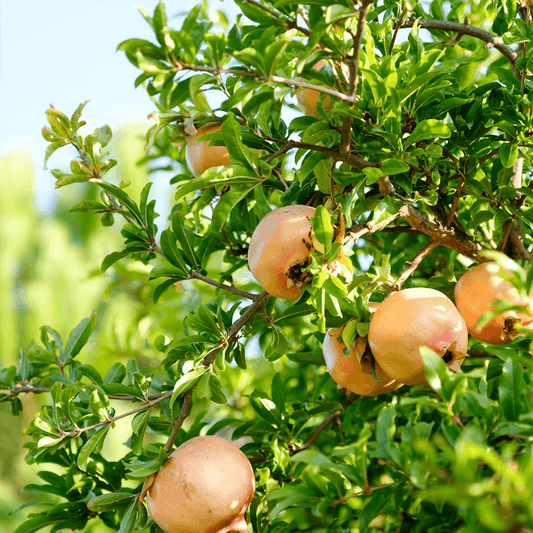Collection: Explore Our Organic Potted Pomegranate Trees
Pomegranate trees (Punica granatum) are prized fruit trees known for their resilience, vibrant appearance, and nutritious fruit packed with edible seeds. Our organic pomegranate trees are well-suited for USDA zones 7–10, thriving in full sun and well-drained soil. Whether you’re an experienced grower or planting your first pomegranate tree, these drought tolerant and cold hardy trees make a beautiful and productive addition to any garden.
Not sure what USDA zone you’re in? Use our Growing Zone Finder to determine your ideal planting conditions.
Key Features of Pomegranate Trees
-
Sunlight: Requires full sun (6–8 hours daily) for strong fruit development.
-
Soil: Grows well in most soil types but needs well-drained soil to avoid root rot.
-
Growth Habit: Can reach up to 25 feet tall and 40 feet wide without pruning.
-
Flowers: Produces striking orange red flowers and red flowers in early summer.
-
Fruit: Yields large pomegranate fruits with juicy, ruby-red edible seeds.
-
Leaves: Glossy, dark green leaves add ornamental value.
-
Chill Hours: Low chill hour requirements make these trees ideal for warmer climates.
-
Cold Tolerance: Cold hardy to around 15°F once established.
Why Choose Potted Pomegranate Trees?
Our collection includes potted pomegranate trees, typically 2 to 2.5 feet tall. Potted trees establish faster than bare root trees and often begin to produce fruit in the same year they are planted. With consistent care during the growing season, they develop strong root systems and high-quality fruit.
Best Practices to Plant and Grow Pomegranate Trees
To successfully plant pomegranate trees and enjoy healthy growth:
-
Site Selection:
Choose a location with full sun and warm, well-drained soil.
-
Watering:
Pomegranate trees are drought tolerant once established but benefit from regular watering during dry spells to increase fruit production.
-
Pruning:
Prune annually to shape the tree and improve airflow. Controlled pruning helps manage tree height and fruit quality.
-
Fertilizing:
Apply balanced fertilizer in early spring to support flowering and fruiting.
Boost Fruit Yield with Cross Pollination
While pomegranate trees are self-fruitful, planting multiple varieties can increase fruit set through cross pollination. This practice may lead to larger harvests and more vibrant, flavorful fruit.
Harvesting Pomegranate Fruits
-
Timing: Fruits ripen in the fall, turning deep red as they mature.
-
Seeds: Easily extract pomegranate seeds by cutting the fruit and tapping it with a spoon.
-
Use: Enjoy the seeds fresh or add them to juices, salads, sauces, and desserts.
Growing Zones and Climate Considerations
Our trees are suitable for USDA zones 7–10, with some varieties adaptable to zone 6. Pomegranates grow best in regions with hot summers—ideal for developing the sweetest fruits during the growing season when daytime temperatures consistently exceed 95°F.
Find your growing zone with our Zone Finder Tool.
Discover varieties that are drought tolerant, cold hardy, and easy to grow. With proper care, your pomegranate tree will produce fruit year after year—offering beauty, resilience, and flavor in every harvest.
Pomegranate Tree Growing Resources
For additional guidance and detailed growing tips, explore these resources:
 Sold out
Sold out







